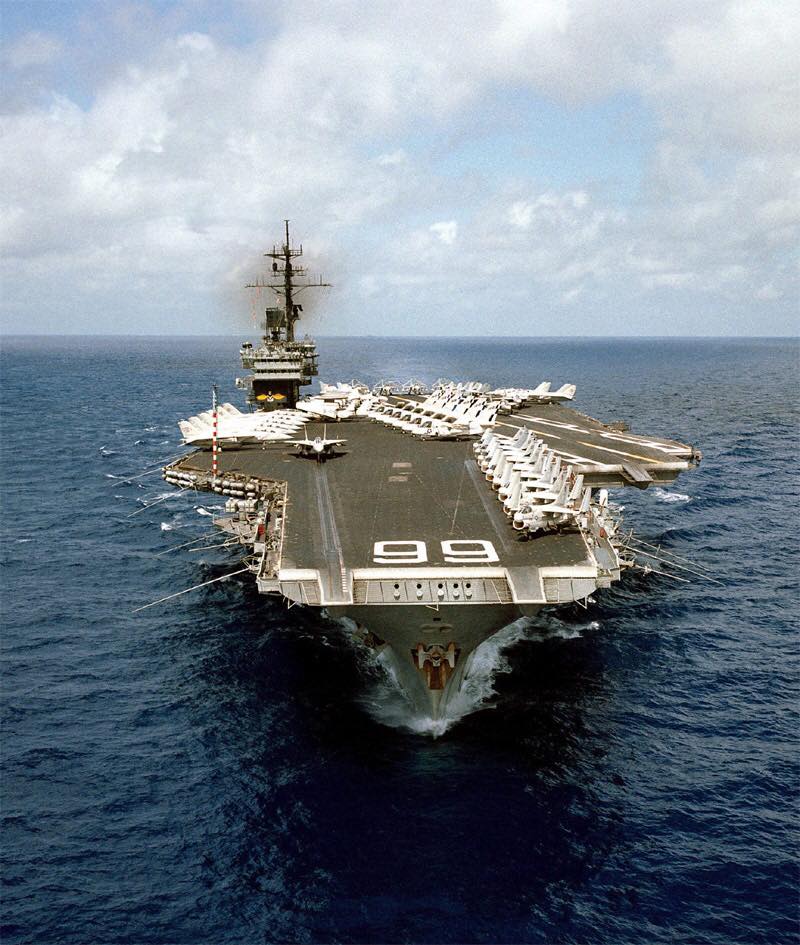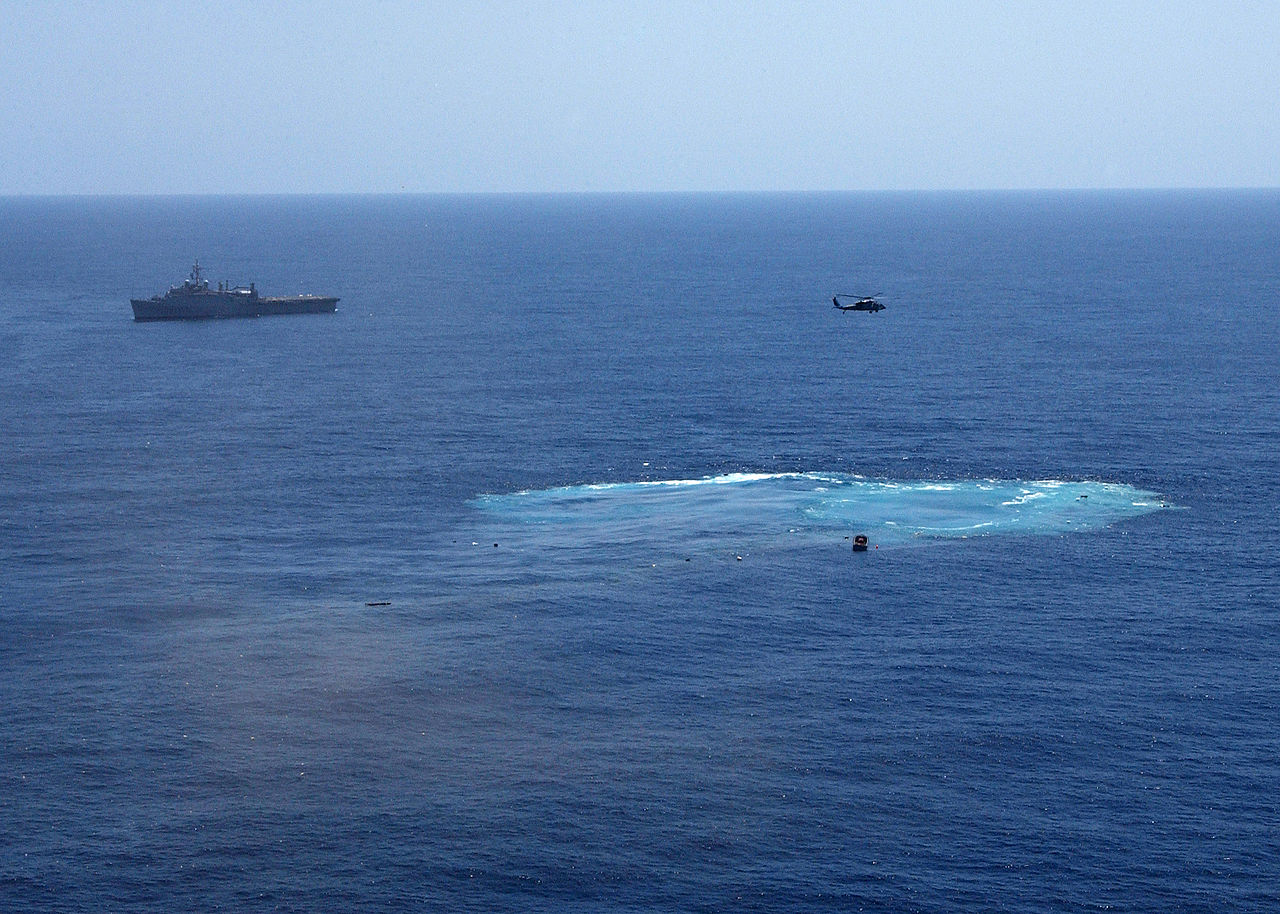On Apr. 19, 2005, USS America left Philadelphia under tow on its final mission. America was towed off the east coast where the ship was finally disposed of during a classified SinkEx.
USS America was the third Kitty Hawk – class aircraft carrier and the third ship in the US Navy to bear the name. Initially commissioned as an attack aircraft carrier CVA 66, she was redesignated as a multi-purpose aircraft carrier CV 66 on Jun. 30, 1975. Decommissioned on Aug. 9, 1996, the USS America spend the following years at the Naval Inactive Ships Facility in Philadelphia.
On Apr. 19, 2005, the carrier left Philadelphia under tow on its final mission. America was towed off the east coast where the ship was finally disposed of during a classified SinkEx.
The USS America is the only supercarrier ever sunk, either on purpose or in combat. Blake Horner, Mechanical Engineer, explains why on Quora “It took four weeks and they ended up having to scuttle her from on board due to her not sinking. She is not only far larger than WWII battleships, but she is also a lot tougher. While she does not have the heavy armor the battleships of yore had, she does have a double-layered hull, meaning weapons have to push through alternating layers of steel and empty pockets to reach her internals.
“On top of that, her internal compartmentalization was far better than that of battleships. She is so large, there are so many more rooms that must be filled in order to make her sink than that of a battleship.
“Additionally, thanks to modern technology, most bombs, torpedoes, and missiles actually have smaller warheads than what they used against WWII vessels. And in the process of the tests, they were actually using controlled explosives, not actual weapons.

“The whole point of the tests was to make future carriers more survivable, as well as see how warships reacted to underwater explosion and damage. Clearly, after taking a beating for four weeks, they can survive a LOT due to just their sheer bulk. But at the same time, the tests were not meant to truly sink her immediately. Thus, there was non“shoot to kill” mindset of the naval officers conducting the test, versus the whole point of attacking enemy battleships being to sink them.
“America lasted so much longer because A) they were not trying to sink her immediately (though they did end up having to board her to make her sink) and B) her sheer bulk made it a lot harder to sink by being able to absorb damage better than battleships.”
America was planned to be sold for scrapping. However, she was chosen to be a live-fire test and evaluation platform in 2005, to aid the design of future aircraft carriers. There was some objection to a ship being named after the U.S. being deliberately sunk at sea, and a committee of her former crew members and other supporters attempted to save the ship for use as a museum ship. Their efforts were ultimately unsuccessful. In a letter to them, then-Vice Chief of Naval Operations Admiral John B. Nathman explained:
“America will make one final and vital contribution to our national defense, this time as a live-fire test and evaluation platform. America’s legacy will serve as a footprint in the design of future carriers — ships that will protect the sons, daughters, grandchildren, and great-grandchildren of American veterans. We will conduct a variety of comprehensive tests above and below the waterline collecting data for use by naval architects and engineers in creating the nation’s future carrier fleet. It is essential we make those ships as highly survivable as possible. When that mission is complete, America will slip quietly beneath the sea. I know America has a very special place in your hearts, not only for the name but also for your service aboard her. I ask that you understand why we selected this ship for this one last crucial mission and make note of the critical nature of her final service.”
Horner concludes:
“Economically, it was the smallest loss to the original cost ratio versus any of the Nimitz class, or even its sister ships of the Kitty Hawk class (USS America never really went through the Navy’s Carrier Service Life Extension Program (SLEP) and therefore, the ship was in bad shape during its last years of service. In the early 1990s, America even had one of her flight deck elevators fall with an S-3B aircraft and several blueshirts on it. Additionally, the carrier suffered steam and fuel leaks and – also in the early 1990s, returning home from deployment – the carrier cut through a Hurricane destroying large parts of the flight deck catwalks.). America was conventionally powered, meaning they did not have to worry about the nuclear radiation of a Nimitz class. It was of similar size and design to the Nimitz so they could learn just as much as they would from sinking one of those in preparation for the Ford class. There were no plans for using her as a potential reactivation ship (one that could come back to service) or as a museum, as she was in very bad condition in comparison to her sisters. It resulted that the potential benefits far outweighed the loss, as the lessons learned from sinking her would allow the Navy to perfect the Gerald R. Ford class, which was under development. It was just a logical decision in allowing the vessel to serve in one last capacity, without having to pay for tearing her apart or letting her sit as a museum. And hopefully, it worked.”

Photo by Photographer’s Mate 2nd Class Michael Sandberg / U.S. Navy

